Supply Chain Management Challenges in Fashion Retail Report
VerifiedAdded on 2022/12/19
|24
|7339
|61
Report
AI Summary
This report delves into the major supply chain challenges confronting fashion retailers on a global scale, providing a comprehensive literature review. It identifies critical issues such as sourcing goods across international borders, inefficient merchandise planning, inaccurate consumer demand forecasting, the complexities of inventory management, difficulties in managing shipment schedules, port customs clearance problems, and challenges in the processing and allocation of goods. The report explores the underlying causes of these supply chain issues and proposes various strategies for their resolution, offering valuable insights for improving efficiency and mitigating risks within the fashion retail industry. The report covers topics such as discipline in sourcing, merchandise planning, demand forecasting, inventory holding, shipment schedules, port custom clearance, and processing and allocation of goods. The report also investigates the causes of these issues and provides strategies to resolve these challenges in supply chain management.
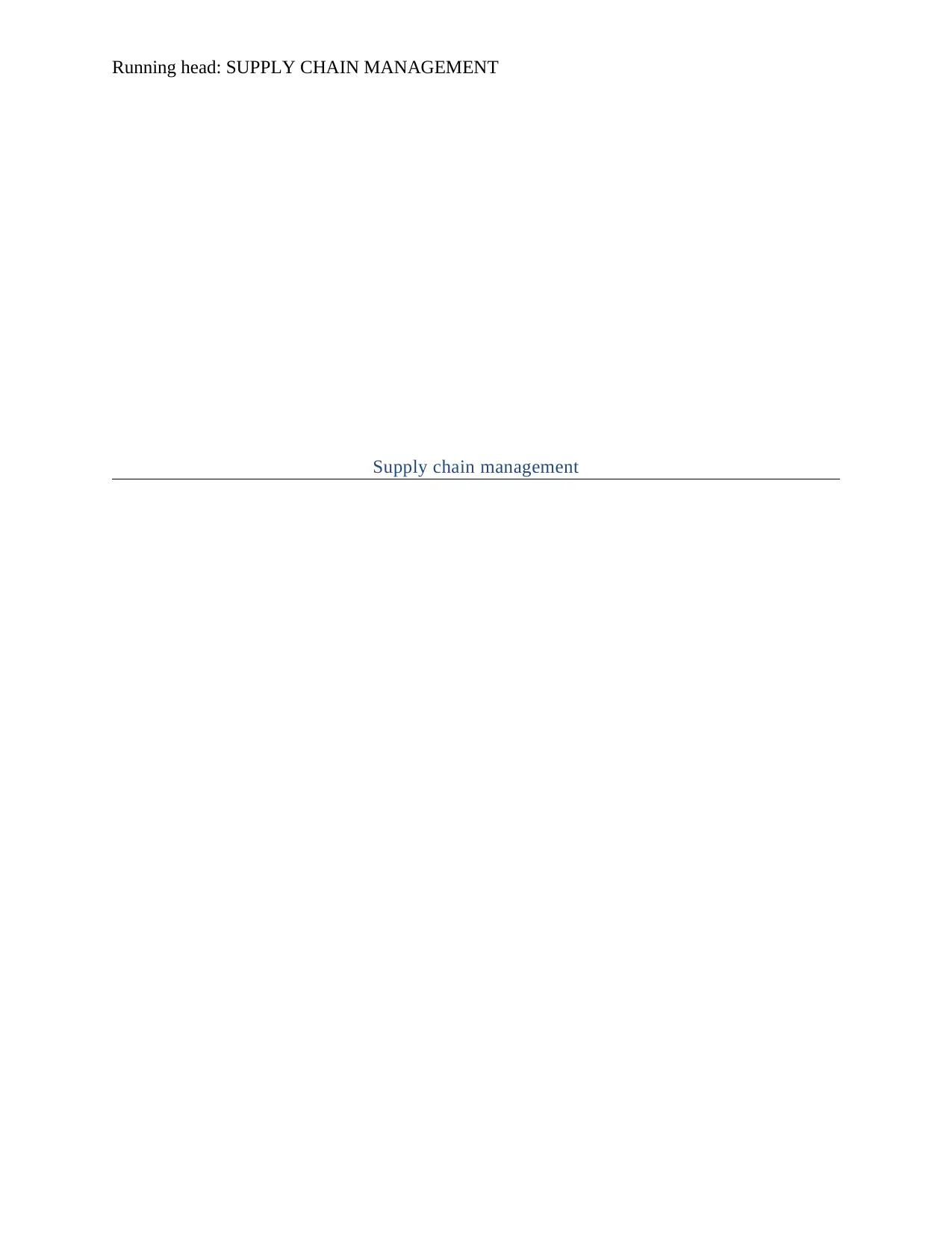
Running head: SUPPLY CHAIN MANAGEMENT
Supply chain management
Supply chain management
Paraphrase This Document
Need a fresh take? Get an instant paraphrase of this document with our AI Paraphraser
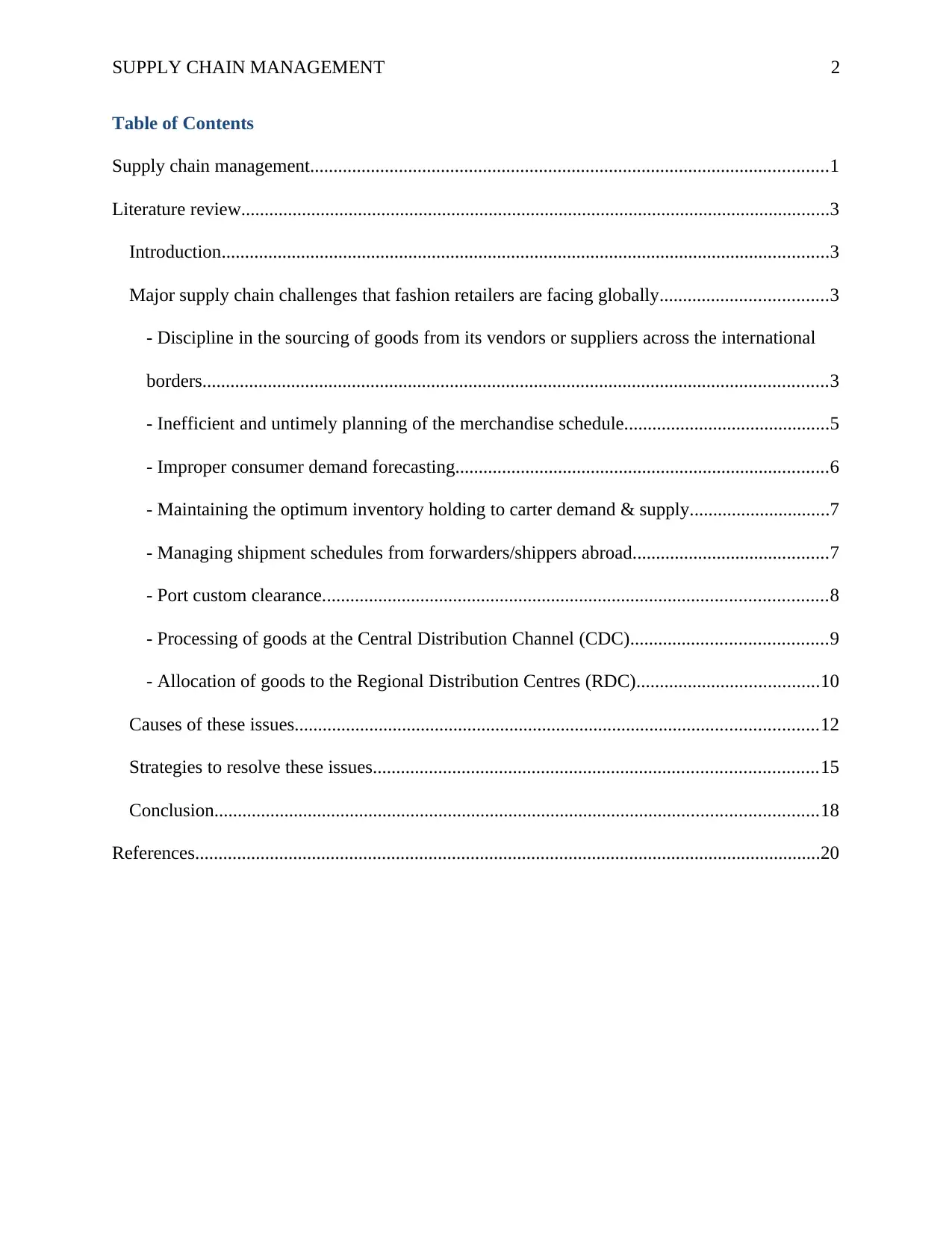
SUPPLY CHAIN MANAGEMENT 2
Table of Contents
Supply chain management...............................................................................................................1
Literature review..............................................................................................................................3
Introduction..................................................................................................................................3
Major supply chain challenges that fashion retailers are facing globally....................................3
- Discipline in the sourcing of goods from its vendors or suppliers across the international
borders......................................................................................................................................3
- Inefficient and untimely planning of the merchandise schedule............................................5
- Improper consumer demand forecasting................................................................................6
- Maintaining the optimum inventory holding to carter demand & supply..............................7
- Managing shipment schedules from forwarders/shippers abroad..........................................7
- Port custom clearance............................................................................................................8
- Processing of goods at the Central Distribution Channel (CDC)..........................................9
- Allocation of goods to the Regional Distribution Centres (RDC).......................................10
Causes of these issues................................................................................................................12
Strategies to resolve these issues...............................................................................................15
Conclusion.................................................................................................................................18
References......................................................................................................................................20
Table of Contents
Supply chain management...............................................................................................................1
Literature review..............................................................................................................................3
Introduction..................................................................................................................................3
Major supply chain challenges that fashion retailers are facing globally....................................3
- Discipline in the sourcing of goods from its vendors or suppliers across the international
borders......................................................................................................................................3
- Inefficient and untimely planning of the merchandise schedule............................................5
- Improper consumer demand forecasting................................................................................6
- Maintaining the optimum inventory holding to carter demand & supply..............................7
- Managing shipment schedules from forwarders/shippers abroad..........................................7
- Port custom clearance............................................................................................................8
- Processing of goods at the Central Distribution Channel (CDC)..........................................9
- Allocation of goods to the Regional Distribution Centres (RDC).......................................10
Causes of these issues................................................................................................................12
Strategies to resolve these issues...............................................................................................15
Conclusion.................................................................................................................................18
References......................................................................................................................................20
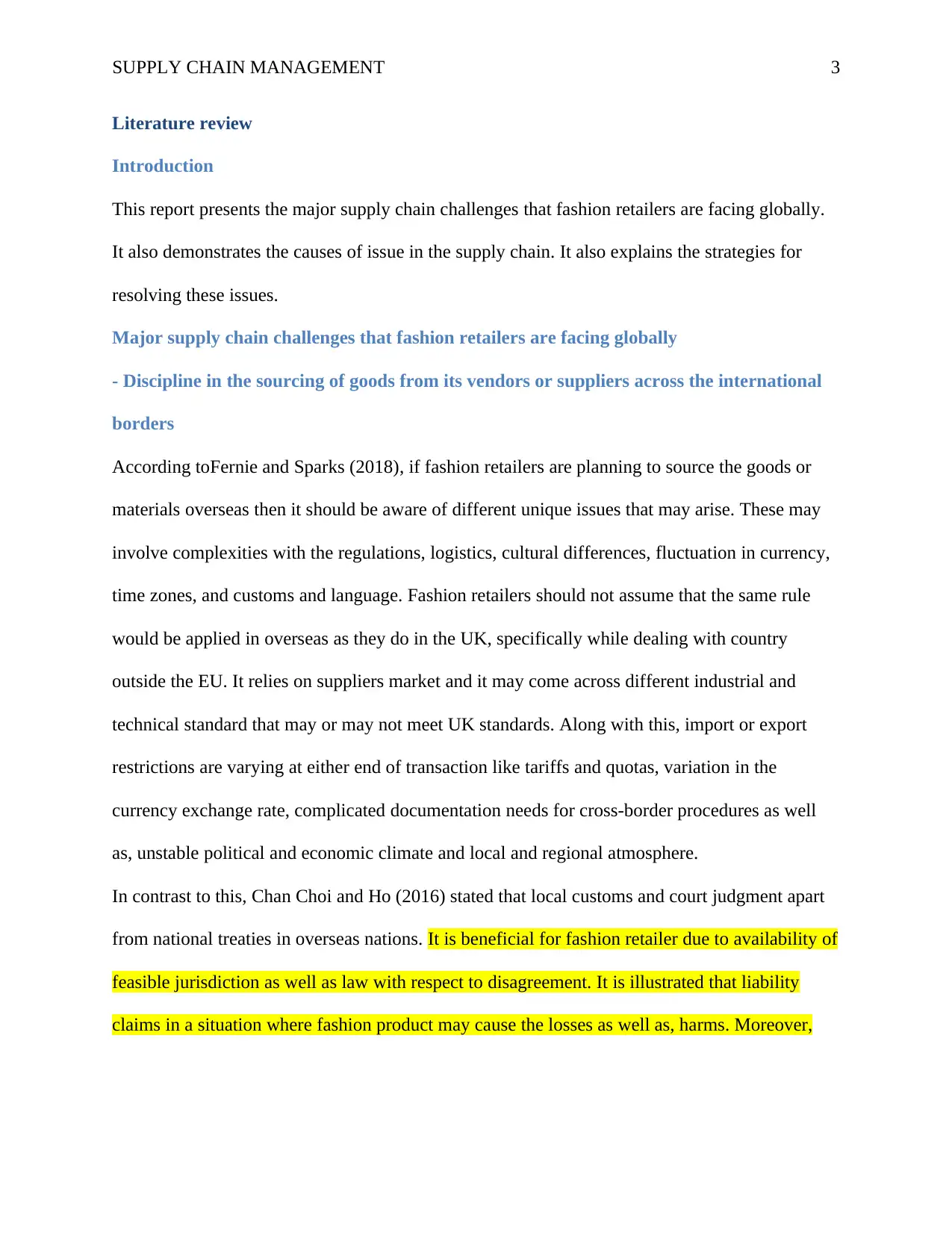
SUPPLY CHAIN MANAGEMENT 3
Literature review
Introduction
This report presents the major supply chain challenges that fashion retailers are facing globally.
It also demonstrates the causes of issue in the supply chain. It also explains the strategies for
resolving these issues.
Major supply chain challenges that fashion retailers are facing globally
- Discipline in the sourcing of goods from its vendors or suppliers across the international
borders
According toFernie and Sparks (2018), if fashion retailers are planning to source the goods or
materials overseas then it should be aware of different unique issues that may arise. These may
involve complexities with the regulations, logistics, cultural differences, fluctuation in currency,
time zones, and customs and language. Fashion retailers should not assume that the same rule
would be applied in overseas as they do in the UK, specifically while dealing with country
outside the EU. It relies on suppliers market and it may come across different industrial and
technical standard that may or may not meet UK standards. Along with this, import or export
restrictions are varying at either end of transaction like tariffs and quotas, variation in the
currency exchange rate, complicated documentation needs for cross-border procedures as well
as, unstable political and economic climate and local and regional atmosphere.
In contrast to this, Chan Choi and Ho (2016) stated that local customs and court judgment apart
from national treaties in overseas nations. It is beneficial for fashion retailer due to availability of
feasible jurisdiction as well as law with respect to disagreement. It is illustrated that liability
claims in a situation where fashion product may cause the losses as well as, harms. Moreover,
Literature review
Introduction
This report presents the major supply chain challenges that fashion retailers are facing globally.
It also demonstrates the causes of issue in the supply chain. It also explains the strategies for
resolving these issues.
Major supply chain challenges that fashion retailers are facing globally
- Discipline in the sourcing of goods from its vendors or suppliers across the international
borders
According toFernie and Sparks (2018), if fashion retailers are planning to source the goods or
materials overseas then it should be aware of different unique issues that may arise. These may
involve complexities with the regulations, logistics, cultural differences, fluctuation in currency,
time zones, and customs and language. Fashion retailers should not assume that the same rule
would be applied in overseas as they do in the UK, specifically while dealing with country
outside the EU. It relies on suppliers market and it may come across different industrial and
technical standard that may or may not meet UK standards. Along with this, import or export
restrictions are varying at either end of transaction like tariffs and quotas, variation in the
currency exchange rate, complicated documentation needs for cross-border procedures as well
as, unstable political and economic climate and local and regional atmosphere.
In contrast to this, Chan Choi and Ho (2016) stated that local customs and court judgment apart
from national treaties in overseas nations. It is beneficial for fashion retailer due to availability of
feasible jurisdiction as well as law with respect to disagreement. It is illustrated that liability
claims in a situation where fashion product may cause the losses as well as, harms. Moreover,
⊘ This is a preview!⊘
Do you want full access?
Subscribe today to unlock all pages.

Trusted by 1+ million students worldwide
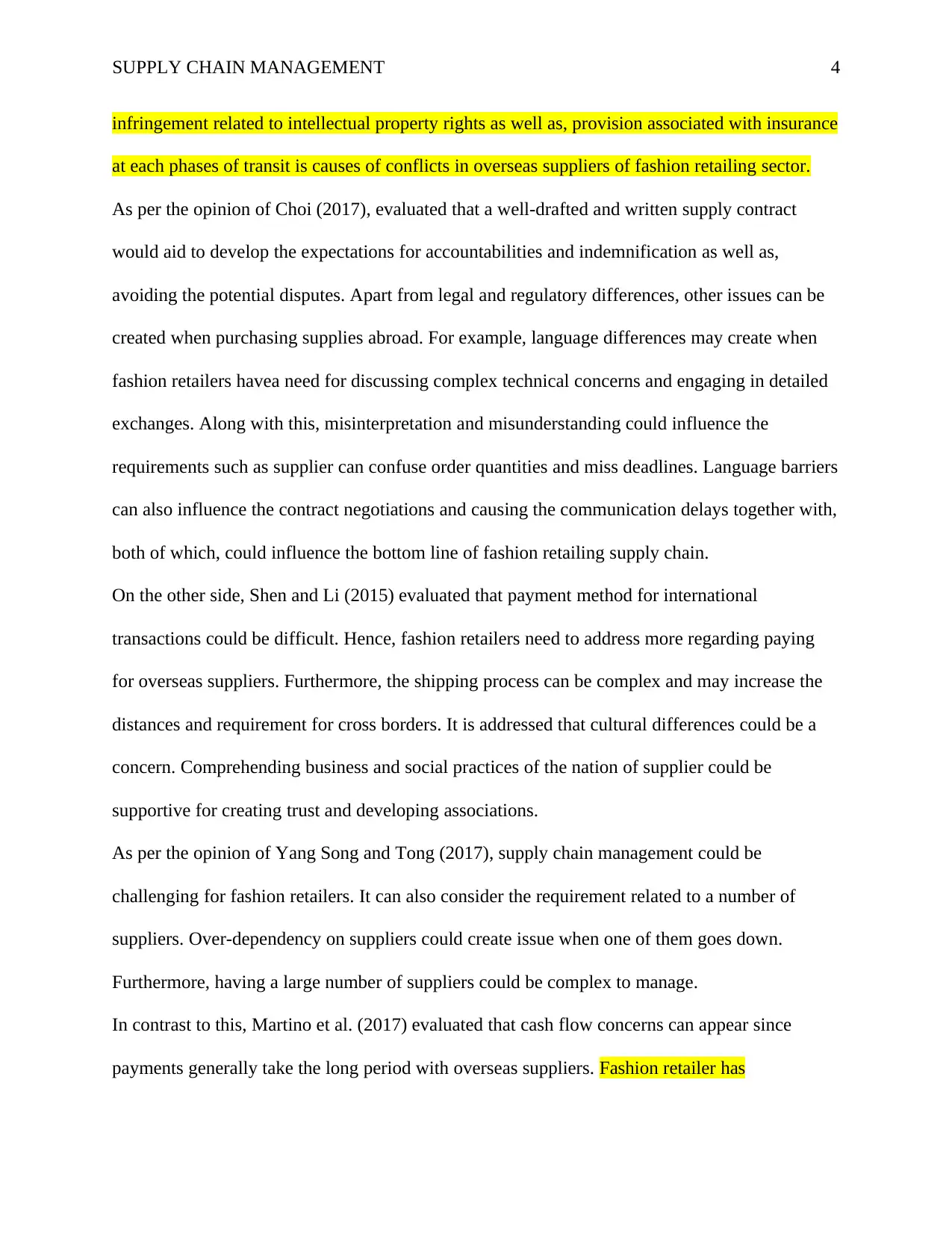
SUPPLY CHAIN MANAGEMENT 4
infringement related to intellectual property rights as well as, provision associated with insurance
at each phases of transit is causes of conflicts in overseas suppliers of fashion retailing sector.
As per the opinion of Choi (2017), evaluated that a well-drafted and written supply contract
would aid to develop the expectations for accountabilities and indemnification as well as,
avoiding the potential disputes. Apart from legal and regulatory differences, other issues can be
created when purchasing supplies abroad. For example, language differences may create when
fashion retailers havea need for discussing complex technical concerns and engaging in detailed
exchanges. Along with this, misinterpretation and misunderstanding could influence the
requirements such as supplier can confuse order quantities and miss deadlines. Language barriers
can also influence the contract negotiations and causing the communication delays together with,
both of which, could influence the bottom line of fashion retailing supply chain.
On the other side, Shen and Li (2015) evaluated that payment method for international
transactions could be difficult. Hence, fashion retailers need to address more regarding paying
for overseas suppliers. Furthermore, the shipping process can be complex and may increase the
distances and requirement for cross borders. It is addressed that cultural differences could be a
concern. Comprehending business and social practices of the nation of supplier could be
supportive for creating trust and developing associations.
As per the opinion of Yang Song and Tong (2017), supply chain management could be
challenging for fashion retailers. It can also consider the requirement related to a number of
suppliers. Over-dependency on suppliers could create issue when one of them goes down.
Furthermore, having a large number of suppliers could be complex to manage.
In contrast to this, Martino et al. (2017) evaluated that cash flow concerns can appear since
payments generally take the long period with overseas suppliers. Fashion retailer has
infringement related to intellectual property rights as well as, provision associated with insurance
at each phases of transit is causes of conflicts in overseas suppliers of fashion retailing sector.
As per the opinion of Choi (2017), evaluated that a well-drafted and written supply contract
would aid to develop the expectations for accountabilities and indemnification as well as,
avoiding the potential disputes. Apart from legal and regulatory differences, other issues can be
created when purchasing supplies abroad. For example, language differences may create when
fashion retailers havea need for discussing complex technical concerns and engaging in detailed
exchanges. Along with this, misinterpretation and misunderstanding could influence the
requirements such as supplier can confuse order quantities and miss deadlines. Language barriers
can also influence the contract negotiations and causing the communication delays together with,
both of which, could influence the bottom line of fashion retailing supply chain.
On the other side, Shen and Li (2015) evaluated that payment method for international
transactions could be difficult. Hence, fashion retailers need to address more regarding paying
for overseas suppliers. Furthermore, the shipping process can be complex and may increase the
distances and requirement for cross borders. It is addressed that cultural differences could be a
concern. Comprehending business and social practices of the nation of supplier could be
supportive for creating trust and developing associations.
As per the opinion of Yang Song and Tong (2017), supply chain management could be
challenging for fashion retailers. It can also consider the requirement related to a number of
suppliers. Over-dependency on suppliers could create issue when one of them goes down.
Furthermore, having a large number of suppliers could be complex to manage.
In contrast to this, Martino et al. (2017) evaluated that cash flow concerns can appear since
payments generally take the long period with overseas suppliers. Fashion retailer has
Paraphrase This Document
Need a fresh take? Get an instant paraphrase of this document with our AI Paraphraser
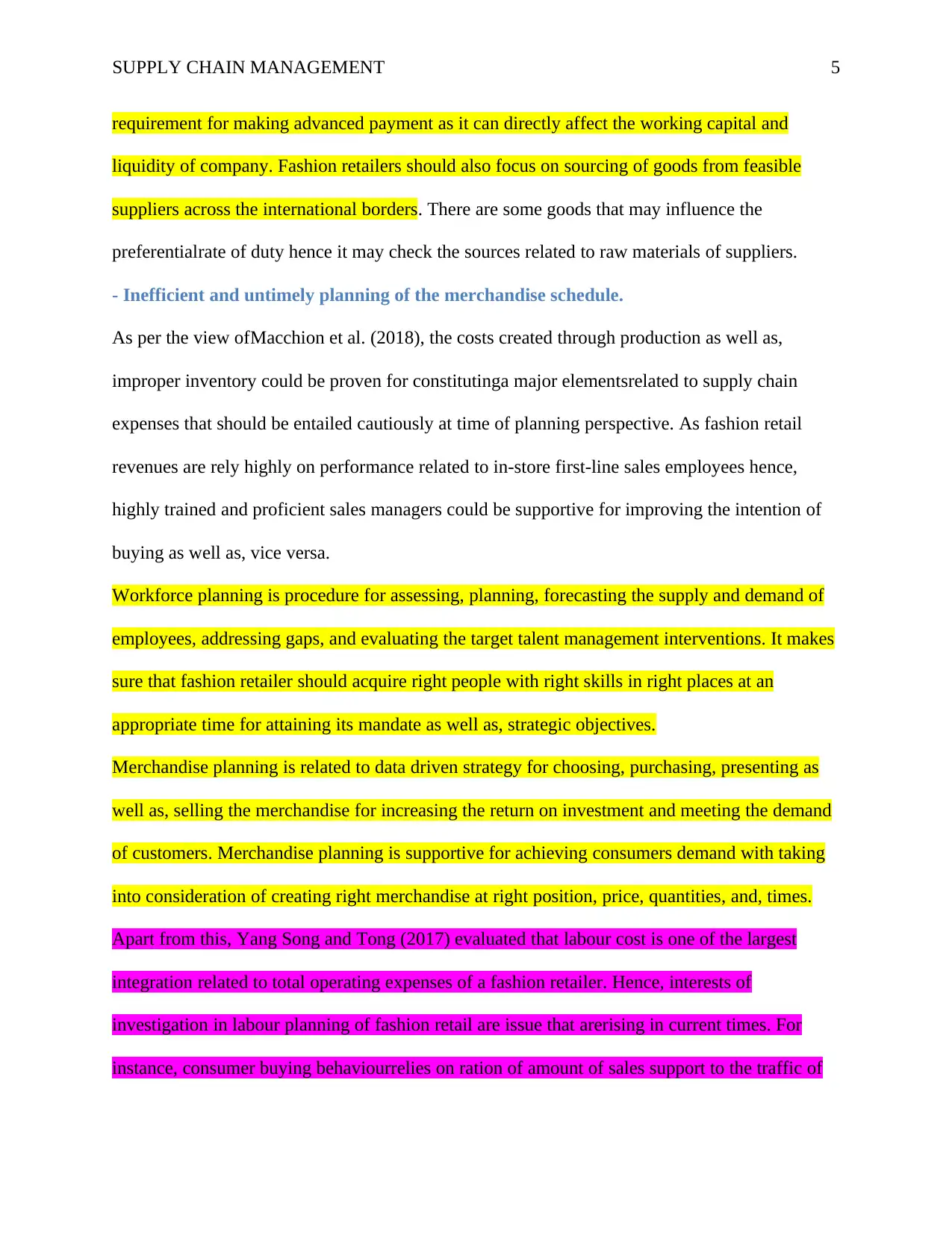
SUPPLY CHAIN MANAGEMENT 5
requirement for making advanced payment as it can directly affect the working capital and
liquidity of company. Fashion retailers should also focus on sourcing of goods from feasible
suppliers across the international borders. There are some goods that may influence the
preferentialrate of duty hence it may check the sources related to raw materials of suppliers.
- Inefficient and untimely planning of the merchandise schedule.
As per the view ofMacchion et al. (2018), the costs created through production as well as,
improper inventory could be proven for constitutinga major elementsrelated to supply chain
expenses that should be entailed cautiously at time of planning perspective. As fashion retail
revenues are rely highly on performance related to in-store first-line sales employees hence,
highly trained and proficient sales managers could be supportive for improving the intention of
buying as well as, vice versa.
Workforce planning is procedure for assessing, planning, forecasting the supply and demand of
employees, addressing gaps, and evaluating the target talent management interventions. It makes
sure that fashion retailer should acquire right people with right skills in right places at an
appropriate time for attaining its mandate as well as, strategic objectives.
Merchandise planning is related to data driven strategy for choosing, purchasing, presenting as
well as, selling the merchandise for increasing the return on investment and meeting the demand
of customers. Merchandise planning is supportive for achieving consumers demand with taking
into consideration of creating right merchandise at right position, price, quantities, and, times.
Apart from this, Yang Song and Tong (2017) evaluated that labour cost is one of the largest
integration related to total operating expenses of a fashion retailer. Hence, interests of
investigation in labour planning of fashion retail are issue that arerising in current times. For
instance, consumer buying behaviourrelies on ration of amount of sales support to the traffic of
requirement for making advanced payment as it can directly affect the working capital and
liquidity of company. Fashion retailers should also focus on sourcing of goods from feasible
suppliers across the international borders. There are some goods that may influence the
preferentialrate of duty hence it may check the sources related to raw materials of suppliers.
- Inefficient and untimely planning of the merchandise schedule.
As per the view ofMacchion et al. (2018), the costs created through production as well as,
improper inventory could be proven for constitutinga major elementsrelated to supply chain
expenses that should be entailed cautiously at time of planning perspective. As fashion retail
revenues are rely highly on performance related to in-store first-line sales employees hence,
highly trained and proficient sales managers could be supportive for improving the intention of
buying as well as, vice versa.
Workforce planning is procedure for assessing, planning, forecasting the supply and demand of
employees, addressing gaps, and evaluating the target talent management interventions. It makes
sure that fashion retailer should acquire right people with right skills in right places at an
appropriate time for attaining its mandate as well as, strategic objectives.
Merchandise planning is related to data driven strategy for choosing, purchasing, presenting as
well as, selling the merchandise for increasing the return on investment and meeting the demand
of customers. Merchandise planning is supportive for achieving consumers demand with taking
into consideration of creating right merchandise at right position, price, quantities, and, times.
Apart from this, Yang Song and Tong (2017) evaluated that labour cost is one of the largest
integration related to total operating expenses of a fashion retailer. Hence, interests of
investigation in labour planning of fashion retail are issue that arerising in current times. For
instance, consumer buying behaviourrelies on ration of amount of sales support to the traffic of
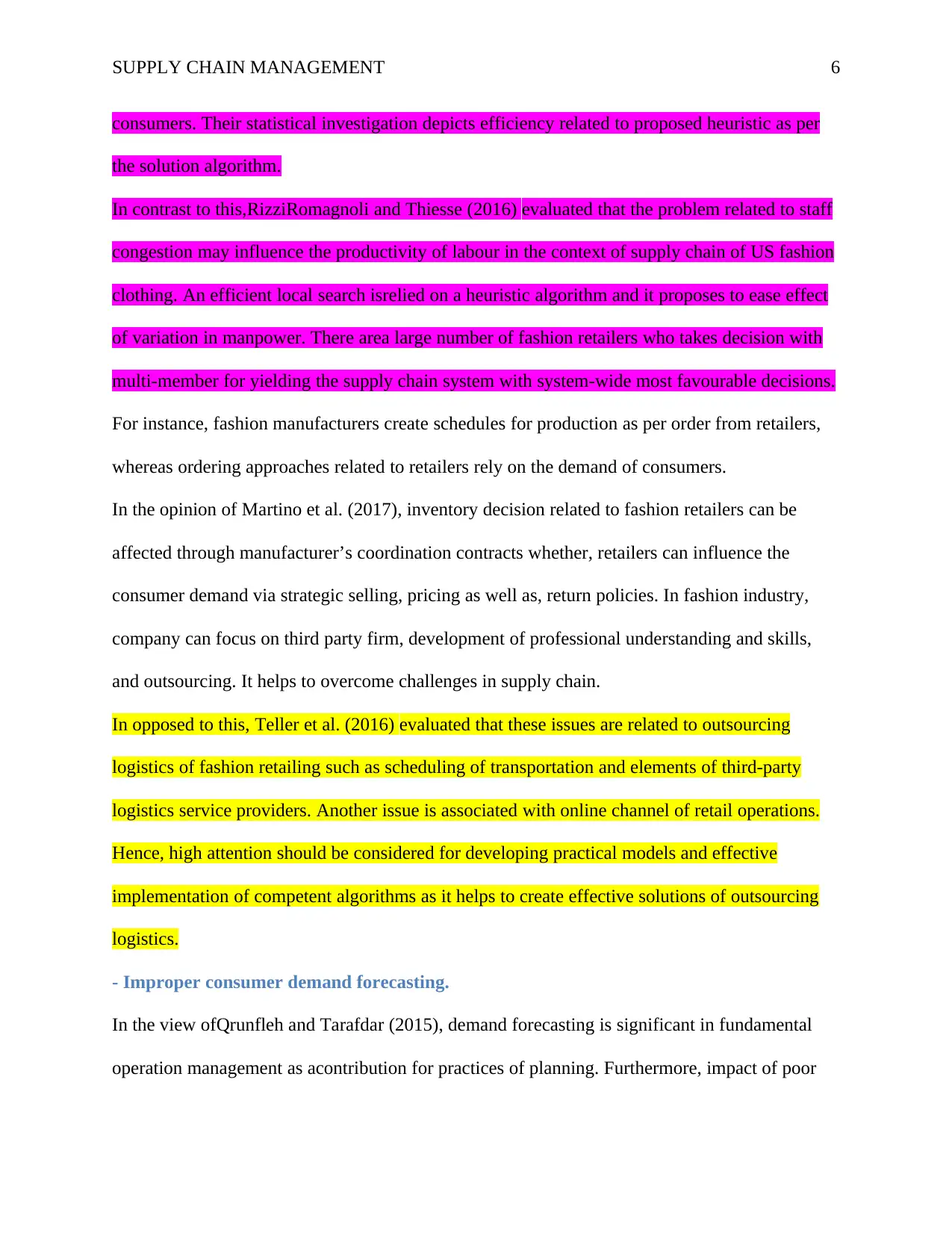
SUPPLY CHAIN MANAGEMENT 6
consumers. Their statistical investigation depicts efficiency related to proposed heuristic as per
the solution algorithm.
In contrast to this,RizziRomagnoli and Thiesse (2016) evaluated that the problem related to staff
congestion may influence the productivity of labour in the context of supply chain of US fashion
clothing. An efficient local search isrelied on a heuristic algorithm and it proposes to ease effect
of variation in manpower. There area large number of fashion retailers who takes decision with
multi-member for yielding the supply chain system with system-wide most favourable decisions.
For instance, fashion manufacturers create schedules for production as per order from retailers,
whereas ordering approaches related to retailers rely on the demand of consumers.
In the opinion of Martino et al. (2017), inventory decision related to fashion retailers can be
affected through manufacturer’s coordination contracts whether, retailers can influence the
consumer demand via strategic selling, pricing as well as, return policies. In fashion industry,
company can focus on third party firm, development of professional understanding and skills,
and outsourcing. It helps to overcome challenges in supply chain.
In opposed to this, Teller et al. (2016) evaluated that these issues are related to outsourcing
logistics of fashion retailing such as scheduling of transportation and elements of third-party
logistics service providers. Another issue is associated with online channel of retail operations.
Hence, high attention should be considered for developing practical models and effective
implementation of competent algorithms as it helps to create effective solutions of outsourcing
logistics.
- Improper consumer demand forecasting.
In the view ofQrunfleh and Tarafdar (2015), demand forecasting is significant in fundamental
operation management as acontribution for practices of planning. Furthermore, impact of poor
consumers. Their statistical investigation depicts efficiency related to proposed heuristic as per
the solution algorithm.
In contrast to this,RizziRomagnoli and Thiesse (2016) evaluated that the problem related to staff
congestion may influence the productivity of labour in the context of supply chain of US fashion
clothing. An efficient local search isrelied on a heuristic algorithm and it proposes to ease effect
of variation in manpower. There area large number of fashion retailers who takes decision with
multi-member for yielding the supply chain system with system-wide most favourable decisions.
For instance, fashion manufacturers create schedules for production as per order from retailers,
whereas ordering approaches related to retailers rely on the demand of consumers.
In the opinion of Martino et al. (2017), inventory decision related to fashion retailers can be
affected through manufacturer’s coordination contracts whether, retailers can influence the
consumer demand via strategic selling, pricing as well as, return policies. In fashion industry,
company can focus on third party firm, development of professional understanding and skills,
and outsourcing. It helps to overcome challenges in supply chain.
In opposed to this, Teller et al. (2016) evaluated that these issues are related to outsourcing
logistics of fashion retailing such as scheduling of transportation and elements of third-party
logistics service providers. Another issue is associated with online channel of retail operations.
Hence, high attention should be considered for developing practical models and effective
implementation of competent algorithms as it helps to create effective solutions of outsourcing
logistics.
- Improper consumer demand forecasting.
In the view ofQrunfleh and Tarafdar (2015), demand forecasting is significant in fundamental
operation management as acontribution for practices of planning. Furthermore, impact of poor
⊘ This is a preview!⊘
Do you want full access?
Subscribe today to unlock all pages.

Trusted by 1+ million students worldwide
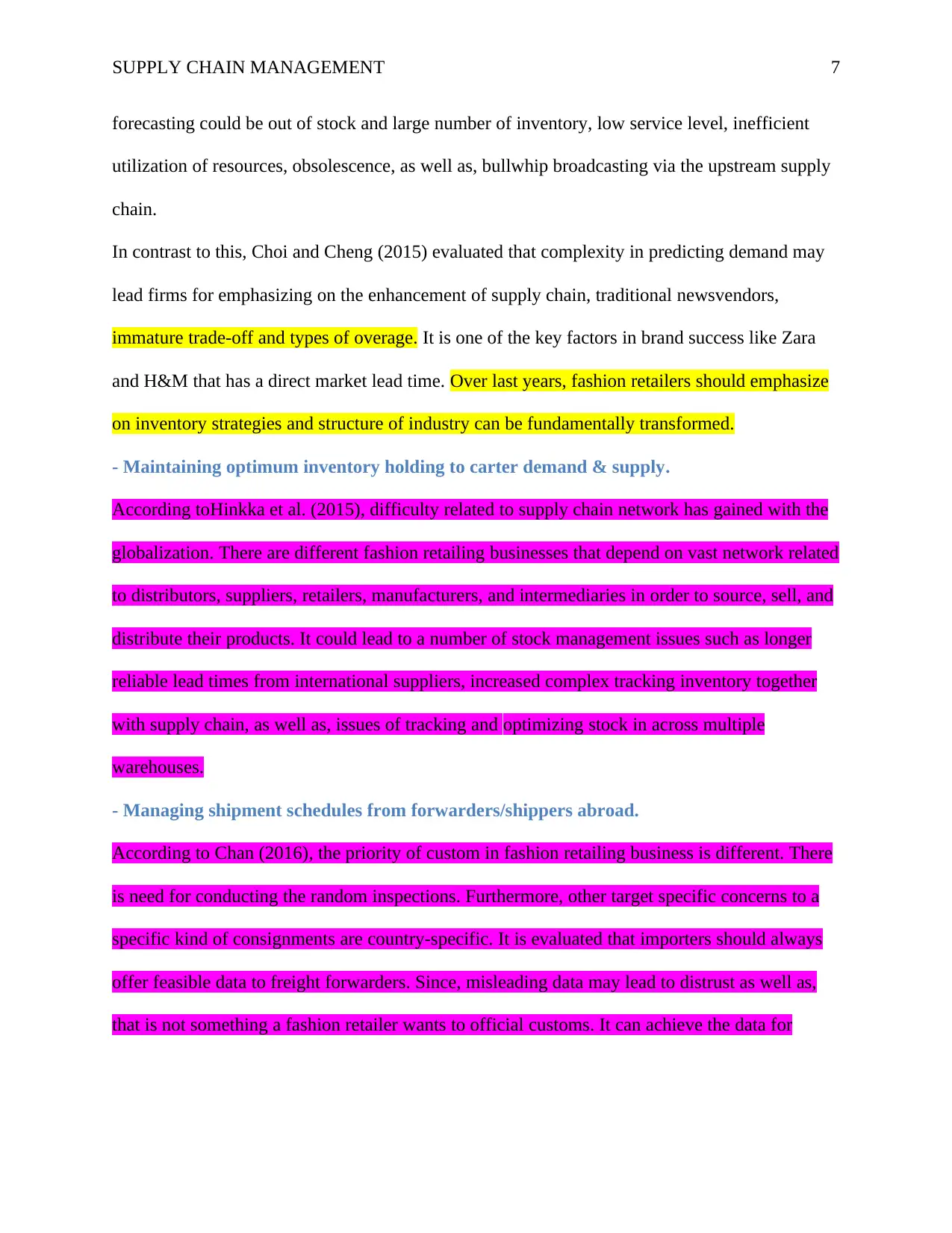
SUPPLY CHAIN MANAGEMENT 7
forecasting could be out of stock and large number of inventory, low service level, inefficient
utilization of resources, obsolescence, as well as, bullwhip broadcasting via the upstream supply
chain.
In contrast to this, Choi and Cheng (2015) evaluated that complexity in predicting demand may
lead firms for emphasizing on the enhancement of supply chain, traditional newsvendors,
immature trade-off and types of overage. It is one of the key factors in brand success like Zara
and H&M that has a direct market lead time. Over last years, fashion retailers should emphasize
on inventory strategies and structure of industry can be fundamentally transformed.
- Maintaining optimum inventory holding to carter demand & supply.
According toHinkka et al. (2015), difficulty related to supply chain network has gained with the
globalization. There are different fashion retailing businesses that depend on vast network related
to distributors, suppliers, retailers, manufacturers, and intermediaries in order to source, sell, and
distribute their products. It could lead to a number of stock management issues such as longer
reliable lead times from international suppliers, increased complex tracking inventory together
with supply chain, as well as, issues of tracking and optimizing stock in across multiple
warehouses.
- Managing shipment schedules from forwarders/shippers abroad.
According to Chan (2016), the priority of custom in fashion retailing business is different. There
is need for conducting the random inspections. Furthermore, other target specific concerns to a
specific kind of consignments are country-specific. It is evaluated that importers should always
offer feasible data to freight forwarders. Since, misleading data may lead to distrust as well as,
that is not something a fashion retailer wants to official customs. It can achieve the data for
forecasting could be out of stock and large number of inventory, low service level, inefficient
utilization of resources, obsolescence, as well as, bullwhip broadcasting via the upstream supply
chain.
In contrast to this, Choi and Cheng (2015) evaluated that complexity in predicting demand may
lead firms for emphasizing on the enhancement of supply chain, traditional newsvendors,
immature trade-off and types of overage. It is one of the key factors in brand success like Zara
and H&M that has a direct market lead time. Over last years, fashion retailers should emphasize
on inventory strategies and structure of industry can be fundamentally transformed.
- Maintaining optimum inventory holding to carter demand & supply.
According toHinkka et al. (2015), difficulty related to supply chain network has gained with the
globalization. There are different fashion retailing businesses that depend on vast network related
to distributors, suppliers, retailers, manufacturers, and intermediaries in order to source, sell, and
distribute their products. It could lead to a number of stock management issues such as longer
reliable lead times from international suppliers, increased complex tracking inventory together
with supply chain, as well as, issues of tracking and optimizing stock in across multiple
warehouses.
- Managing shipment schedules from forwarders/shippers abroad.
According to Chan (2016), the priority of custom in fashion retailing business is different. There
is need for conducting the random inspections. Furthermore, other target specific concerns to a
specific kind of consignments are country-specific. It is evaluated that importers should always
offer feasible data to freight forwarders. Since, misleading data may lead to distrust as well as,
that is not something a fashion retailer wants to official customs. It can achieve the data for
Paraphrase This Document
Need a fresh take? Get an instant paraphrase of this document with our AI Paraphraser
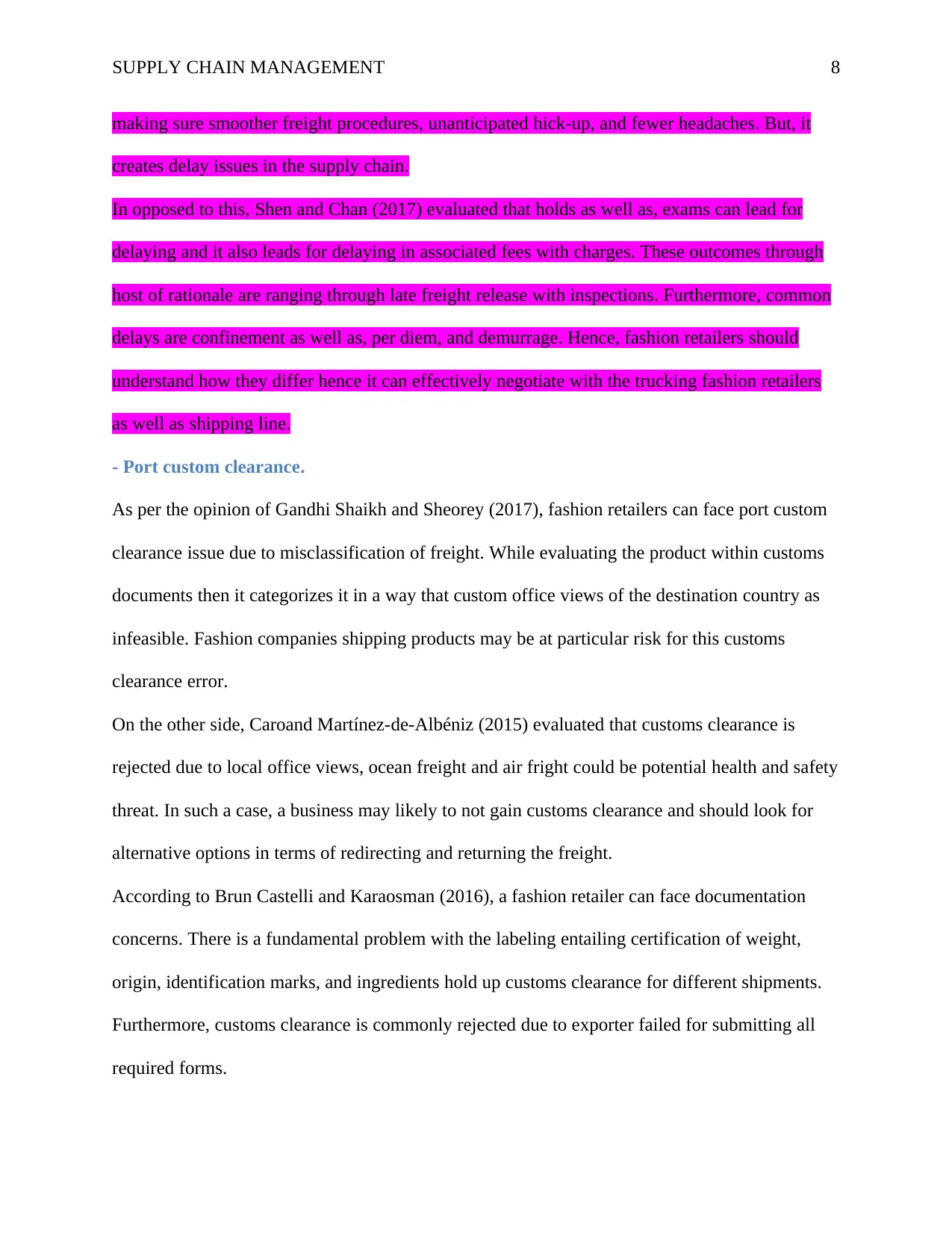
SUPPLY CHAIN MANAGEMENT 8
making sure smoother freight procedures, unanticipated hick-up, and fewer headaches. But, it
creates delay issues in the supply chain.
In opposed to this, Shen and Chan (2017) evaluated that holds as well as, exams can lead for
delaying and it also leads for delaying in associated fees with charges. These outcomes through
host of rationale are ranging through late freight release with inspections. Furthermore, common
delays are confinement as well as, per diem, and demurrage. Hence, fashion retailers should
understand how they differ hence it can effectively negotiate with the trucking fashion retailers
as well as shipping line.
- Port custom clearance.
As per the opinion of Gandhi Shaikh and Sheorey (2017), fashion retailers can face port custom
clearance issue due to misclassification of freight. While evaluating the product within customs
documents then it categorizes it in a way that custom office views of the destination country as
infeasible. Fashion companies shipping products may be at particular risk for this customs
clearance error.
On the other side, Caroand Martínez-de-Albéniz (2015) evaluated that customs clearance is
rejected due to local office views, ocean freight and air fright could be potential health and safety
threat. In such a case, a business may likely to not gain customs clearance and should look for
alternative options in terms of redirecting and returning the freight.
According to Brun Castelli and Karaosman (2016), a fashion retailer can face documentation
concerns. There is a fundamental problem with the labeling entailing certification of weight,
origin, identification marks, and ingredients hold up customs clearance for different shipments.
Furthermore, customs clearance is commonly rejected due to exporter failed for submitting all
required forms.
making sure smoother freight procedures, unanticipated hick-up, and fewer headaches. But, it
creates delay issues in the supply chain.
In opposed to this, Shen and Chan (2017) evaluated that holds as well as, exams can lead for
delaying and it also leads for delaying in associated fees with charges. These outcomes through
host of rationale are ranging through late freight release with inspections. Furthermore, common
delays are confinement as well as, per diem, and demurrage. Hence, fashion retailers should
understand how they differ hence it can effectively negotiate with the trucking fashion retailers
as well as shipping line.
- Port custom clearance.
As per the opinion of Gandhi Shaikh and Sheorey (2017), fashion retailers can face port custom
clearance issue due to misclassification of freight. While evaluating the product within customs
documents then it categorizes it in a way that custom office views of the destination country as
infeasible. Fashion companies shipping products may be at particular risk for this customs
clearance error.
On the other side, Caroand Martínez-de-Albéniz (2015) evaluated that customs clearance is
rejected due to local office views, ocean freight and air fright could be potential health and safety
threat. In such a case, a business may likely to not gain customs clearance and should look for
alternative options in terms of redirecting and returning the freight.
According to Brun Castelli and Karaosman (2016), a fashion retailer can face documentation
concerns. There is a fundamental problem with the labeling entailing certification of weight,
origin, identification marks, and ingredients hold up customs clearance for different shipments.
Furthermore, customs clearance is commonly rejected due to exporter failed for submitting all
required forms.
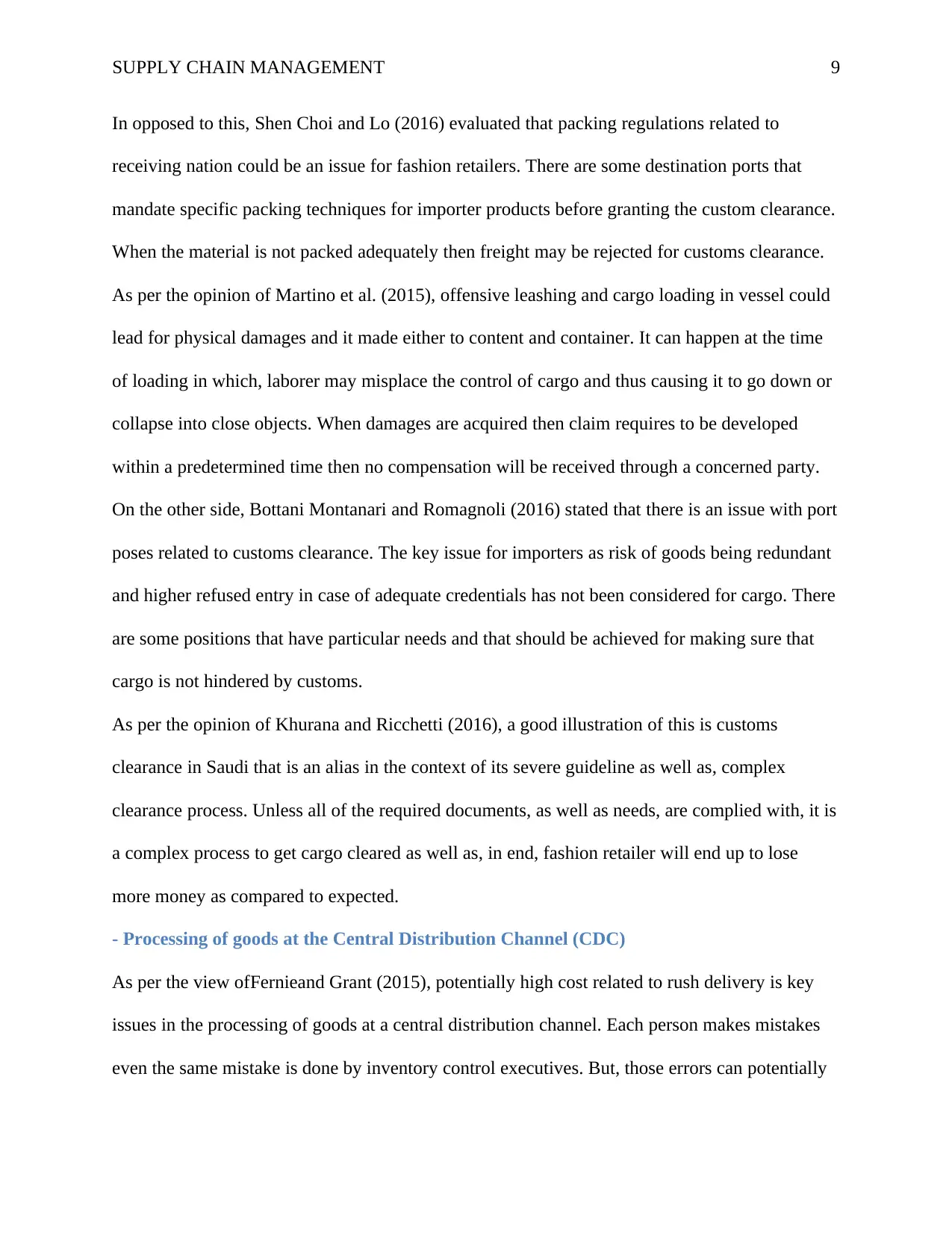
SUPPLY CHAIN MANAGEMENT 9
In opposed to this, Shen Choi and Lo (2016) evaluated that packing regulations related to
receiving nation could be an issue for fashion retailers. There are some destination ports that
mandate specific packing techniques for importer products before granting the custom clearance.
When the material is not packed adequately then freight may be rejected for customs clearance.
As per the opinion of Martino et al. (2015), offensive leashing and cargo loading in vessel could
lead for physical damages and it made either to content and container. It can happen at the time
of loading in which, laborer may misplace the control of cargo and thus causing it to go down or
collapse into close objects. When damages are acquired then claim requires to be developed
within a predetermined time then no compensation will be received through a concerned party.
On the other side, Bottani Montanari and Romagnoli (2016) stated that there is an issue with port
poses related to customs clearance. The key issue for importers as risk of goods being redundant
and higher refused entry in case of adequate credentials has not been considered for cargo. There
are some positions that have particular needs and that should be achieved for making sure that
cargo is not hindered by customs.
As per the opinion of Khurana and Ricchetti (2016), a good illustration of this is customs
clearance in Saudi that is an alias in the context of its severe guideline as well as, complex
clearance process. Unless all of the required documents, as well as needs, are complied with, it is
a complex process to get cargo cleared as well as, in end, fashion retailer will end up to lose
more money as compared to expected.
- Processing of goods at the Central Distribution Channel (CDC)
As per the view ofFernieand Grant (2015), potentially high cost related to rush delivery is key
issues in the processing of goods at a central distribution channel. Each person makes mistakes
even the same mistake is done by inventory control executives. But, those errors can potentially
In opposed to this, Shen Choi and Lo (2016) evaluated that packing regulations related to
receiving nation could be an issue for fashion retailers. There are some destination ports that
mandate specific packing techniques for importer products before granting the custom clearance.
When the material is not packed adequately then freight may be rejected for customs clearance.
As per the opinion of Martino et al. (2015), offensive leashing and cargo loading in vessel could
lead for physical damages and it made either to content and container. It can happen at the time
of loading in which, laborer may misplace the control of cargo and thus causing it to go down or
collapse into close objects. When damages are acquired then claim requires to be developed
within a predetermined time then no compensation will be received through a concerned party.
On the other side, Bottani Montanari and Romagnoli (2016) stated that there is an issue with port
poses related to customs clearance. The key issue for importers as risk of goods being redundant
and higher refused entry in case of adequate credentials has not been considered for cargo. There
are some positions that have particular needs and that should be achieved for making sure that
cargo is not hindered by customs.
As per the opinion of Khurana and Ricchetti (2016), a good illustration of this is customs
clearance in Saudi that is an alias in the context of its severe guideline as well as, complex
clearance process. Unless all of the required documents, as well as needs, are complied with, it is
a complex process to get cargo cleared as well as, in end, fashion retailer will end up to lose
more money as compared to expected.
- Processing of goods at the Central Distribution Channel (CDC)
As per the view ofFernieand Grant (2015), potentially high cost related to rush delivery is key
issues in the processing of goods at a central distribution channel. Each person makes mistakes
even the same mistake is done by inventory control executives. But, those errors can potentially
⊘ This is a preview!⊘
Do you want full access?
Subscribe today to unlock all pages.

Trusted by 1+ million students worldwide
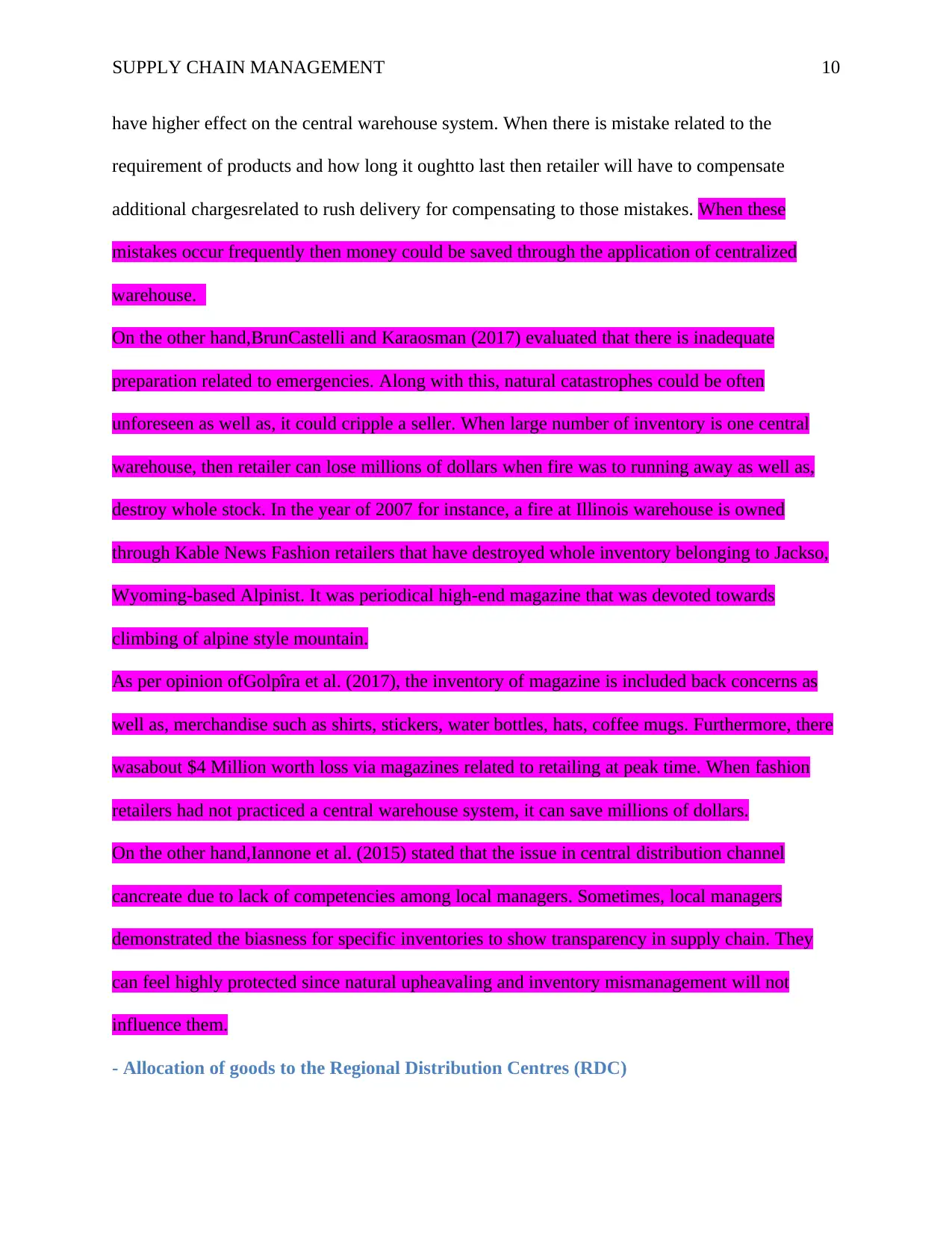
SUPPLY CHAIN MANAGEMENT 10
have higher effect on the central warehouse system. When there is mistake related to the
requirement of products and how long it oughtto last then retailer will have to compensate
additional chargesrelated to rush delivery for compensating to those mistakes. When these
mistakes occur frequently then money could be saved through the application of centralized
warehouse.
On the other hand,BrunCastelli and Karaosman (2017) evaluated that there is inadequate
preparation related to emergencies. Along with this, natural catastrophes could be often
unforeseen as well as, it could cripple a seller. When large number of inventory is one central
warehouse, then retailer can lose millions of dollars when fire was to running away as well as,
destroy whole stock. In the year of 2007 for instance, a fire at Illinois warehouse is owned
through Kable News Fashion retailers that have destroyed whole inventory belonging to Jackso,
Wyoming-based Alpinist. It was periodical high-end magazine that was devoted towards
climbing of alpine style mountain.
As per opinion ofGolpîra et al. (2017), the inventory of magazine is included back concerns as
well as, merchandise such as shirts, stickers, water bottles, hats, coffee mugs. Furthermore, there
wasabout $4 Million worth loss via magazines related to retailing at peak time. When fashion
retailers had not practiced a central warehouse system, it can save millions of dollars.
On the other hand,Iannone et al. (2015) stated that the issue in central distribution channel
cancreate due to lack of competencies among local managers. Sometimes, local managers
demonstrated the biasness for specific inventories to show transparency in supply chain. They
can feel highly protected since natural upheavaling and inventory mismanagement will not
influence them.
- Allocation of goods to the Regional Distribution Centres (RDC)
have higher effect on the central warehouse system. When there is mistake related to the
requirement of products and how long it oughtto last then retailer will have to compensate
additional chargesrelated to rush delivery for compensating to those mistakes. When these
mistakes occur frequently then money could be saved through the application of centralized
warehouse.
On the other hand,BrunCastelli and Karaosman (2017) evaluated that there is inadequate
preparation related to emergencies. Along with this, natural catastrophes could be often
unforeseen as well as, it could cripple a seller. When large number of inventory is one central
warehouse, then retailer can lose millions of dollars when fire was to running away as well as,
destroy whole stock. In the year of 2007 for instance, a fire at Illinois warehouse is owned
through Kable News Fashion retailers that have destroyed whole inventory belonging to Jackso,
Wyoming-based Alpinist. It was periodical high-end magazine that was devoted towards
climbing of alpine style mountain.
As per opinion ofGolpîra et al. (2017), the inventory of magazine is included back concerns as
well as, merchandise such as shirts, stickers, water bottles, hats, coffee mugs. Furthermore, there
wasabout $4 Million worth loss via magazines related to retailing at peak time. When fashion
retailers had not practiced a central warehouse system, it can save millions of dollars.
On the other hand,Iannone et al. (2015) stated that the issue in central distribution channel
cancreate due to lack of competencies among local managers. Sometimes, local managers
demonstrated the biasness for specific inventories to show transparency in supply chain. They
can feel highly protected since natural upheavaling and inventory mismanagement will not
influence them.
- Allocation of goods to the Regional Distribution Centres (RDC)
Paraphrase This Document
Need a fresh take? Get an instant paraphrase of this document with our AI Paraphraser
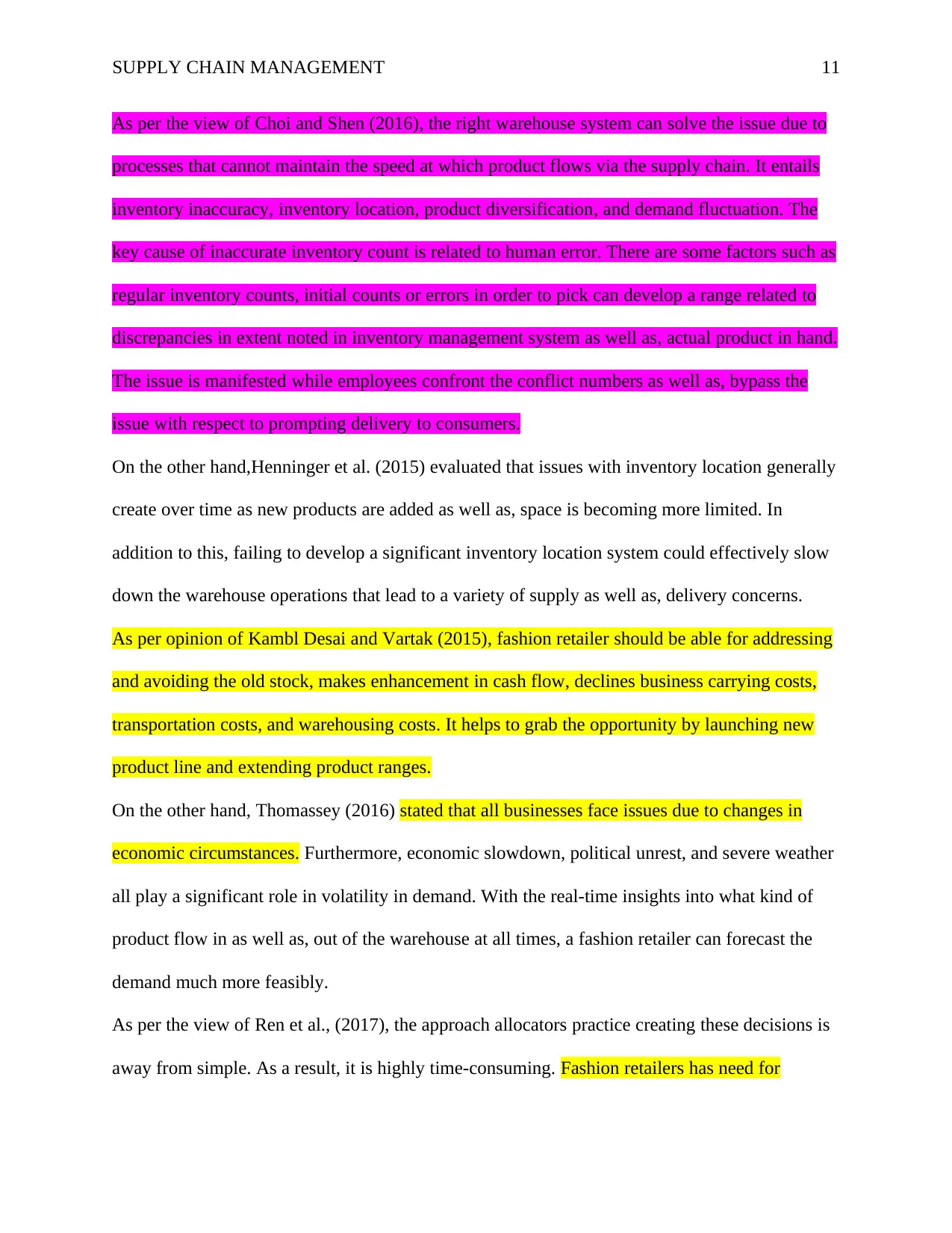
SUPPLY CHAIN MANAGEMENT 11
As per the view of Choi and Shen (2016), the right warehouse system can solve the issue due to
processes that cannot maintain the speed at which product flows via the supply chain. It entails
inventory inaccuracy, inventory location, product diversification, and demand fluctuation. The
key cause of inaccurate inventory count is related to human error. There are some factors such as
regular inventory counts, initial counts or errors in order to pick can develop a range related to
discrepancies in extent noted in inventory management system as well as, actual product in hand.
The issue is manifested while employees confront the conflict numbers as well as, bypass the
issue with respect to prompting delivery to consumers.
On the other hand,Henninger et al. (2015) evaluated that issues with inventory location generally
create over time as new products are added as well as, space is becoming more limited. In
addition to this, failing to develop a significant inventory location system could effectively slow
down the warehouse operations that lead to a variety of supply as well as, delivery concerns.
As per opinion of Kambl Desai and Vartak (2015), fashion retailer should be able for addressing
and avoiding the old stock, makes enhancement in cash flow, declines business carrying costs,
transportation costs, and warehousing costs. It helps to grab the opportunity by launching new
product line and extending product ranges.
On the other hand, Thomassey (2016) stated that all businesses face issues due to changes in
economic circumstances. Furthermore, economic slowdown, political unrest, and severe weather
all play a significant role in volatility in demand. With the real-time insights into what kind of
product flow in as well as, out of the warehouse at all times, a fashion retailer can forecast the
demand much more feasibly.
As per the view of Ren et al., (2017), the approach allocators practice creating these decisions is
away from simple. As a result, it is highly time-consuming. Fashion retailers has need for
As per the view of Choi and Shen (2016), the right warehouse system can solve the issue due to
processes that cannot maintain the speed at which product flows via the supply chain. It entails
inventory inaccuracy, inventory location, product diversification, and demand fluctuation. The
key cause of inaccurate inventory count is related to human error. There are some factors such as
regular inventory counts, initial counts or errors in order to pick can develop a range related to
discrepancies in extent noted in inventory management system as well as, actual product in hand.
The issue is manifested while employees confront the conflict numbers as well as, bypass the
issue with respect to prompting delivery to consumers.
On the other hand,Henninger et al. (2015) evaluated that issues with inventory location generally
create over time as new products are added as well as, space is becoming more limited. In
addition to this, failing to develop a significant inventory location system could effectively slow
down the warehouse operations that lead to a variety of supply as well as, delivery concerns.
As per opinion of Kambl Desai and Vartak (2015), fashion retailer should be able for addressing
and avoiding the old stock, makes enhancement in cash flow, declines business carrying costs,
transportation costs, and warehousing costs. It helps to grab the opportunity by launching new
product line and extending product ranges.
On the other hand, Thomassey (2016) stated that all businesses face issues due to changes in
economic circumstances. Furthermore, economic slowdown, political unrest, and severe weather
all play a significant role in volatility in demand. With the real-time insights into what kind of
product flow in as well as, out of the warehouse at all times, a fashion retailer can forecast the
demand much more feasibly.
As per the view of Ren et al., (2017), the approach allocators practice creating these decisions is
away from simple. As a result, it is highly time-consuming. Fashion retailers has need for
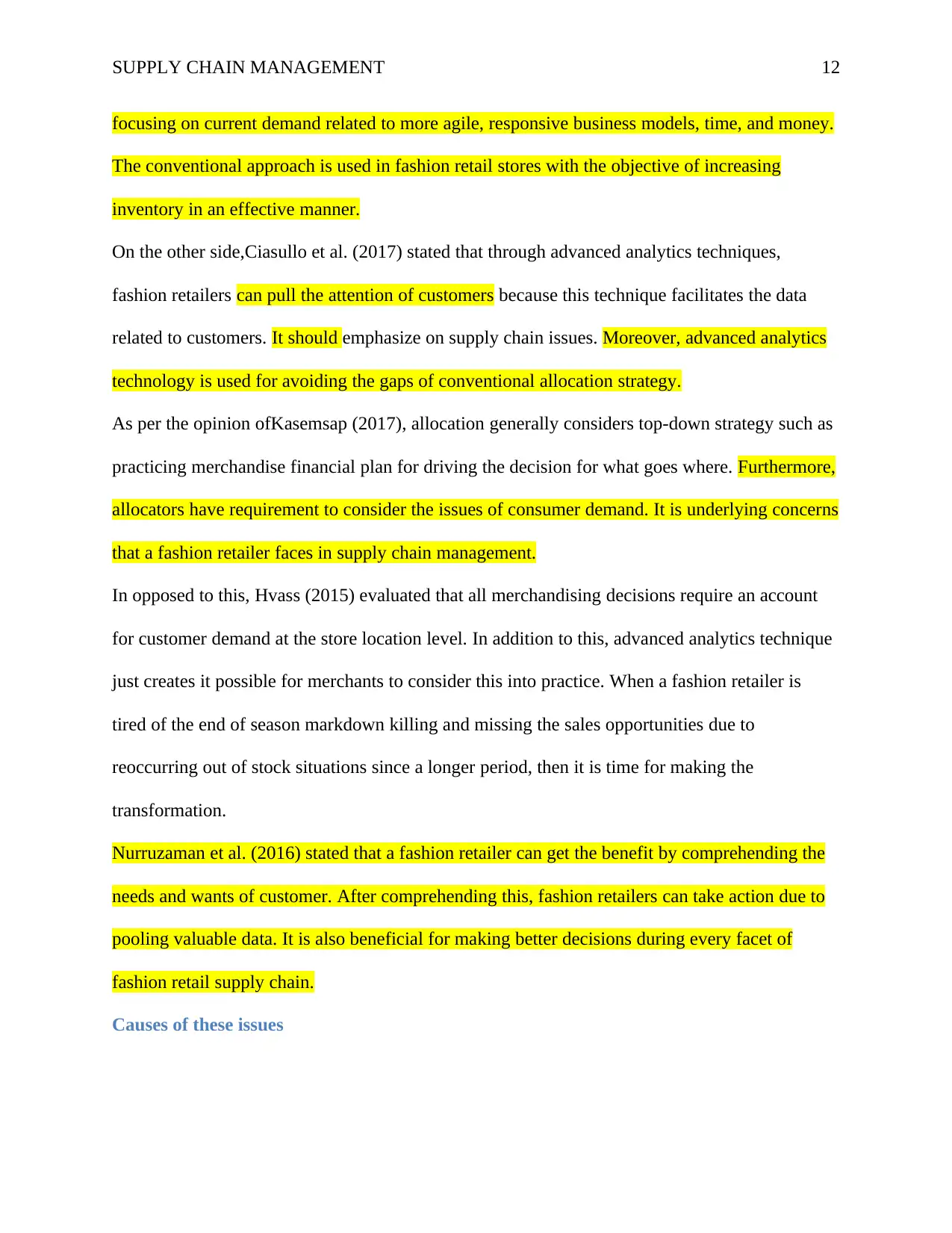
SUPPLY CHAIN MANAGEMENT 12
focusing on current demand related to more agile, responsive business models, time, and money.
The conventional approach is used in fashion retail stores with the objective of increasing
inventory in an effective manner.
On the other side,Ciasullo et al. (2017) stated that through advanced analytics techniques,
fashion retailers can pull the attention of customers because this technique facilitates the data
related to customers. It should emphasize on supply chain issues. Moreover, advanced analytics
technology is used for avoiding the gaps of conventional allocation strategy.
As per the opinion ofKasemsap (2017), allocation generally considers top-down strategy such as
practicing merchandise financial plan for driving the decision for what goes where. Furthermore,
allocators have requirement to consider the issues of consumer demand. It is underlying concerns
that a fashion retailer faces in supply chain management.
In opposed to this, Hvass (2015) evaluated that all merchandising decisions require an account
for customer demand at the store location level. In addition to this, advanced analytics technique
just creates it possible for merchants to consider this into practice. When a fashion retailer is
tired of the end of season markdown killing and missing the sales opportunities due to
reoccurring out of stock situations since a longer period, then it is time for making the
transformation.
Nurruzaman et al. (2016) stated that a fashion retailer can get the benefit by comprehending the
needs and wants of customer. After comprehending this, fashion retailers can take action due to
pooling valuable data. It is also beneficial for making better decisions during every facet of
fashion retail supply chain.
Causes of these issues
focusing on current demand related to more agile, responsive business models, time, and money.
The conventional approach is used in fashion retail stores with the objective of increasing
inventory in an effective manner.
On the other side,Ciasullo et al. (2017) stated that through advanced analytics techniques,
fashion retailers can pull the attention of customers because this technique facilitates the data
related to customers. It should emphasize on supply chain issues. Moreover, advanced analytics
technology is used for avoiding the gaps of conventional allocation strategy.
As per the opinion ofKasemsap (2017), allocation generally considers top-down strategy such as
practicing merchandise financial plan for driving the decision for what goes where. Furthermore,
allocators have requirement to consider the issues of consumer demand. It is underlying concerns
that a fashion retailer faces in supply chain management.
In opposed to this, Hvass (2015) evaluated that all merchandising decisions require an account
for customer demand at the store location level. In addition to this, advanced analytics technique
just creates it possible for merchants to consider this into practice. When a fashion retailer is
tired of the end of season markdown killing and missing the sales opportunities due to
reoccurring out of stock situations since a longer period, then it is time for making the
transformation.
Nurruzaman et al. (2016) stated that a fashion retailer can get the benefit by comprehending the
needs and wants of customer. After comprehending this, fashion retailers can take action due to
pooling valuable data. It is also beneficial for making better decisions during every facet of
fashion retail supply chain.
Causes of these issues
⊘ This is a preview!⊘
Do you want full access?
Subscribe today to unlock all pages.

Trusted by 1+ million students worldwide
1 out of 24
Related Documents
Your All-in-One AI-Powered Toolkit for Academic Success.
+13062052269
info@desklib.com
Available 24*7 on WhatsApp / Email
![[object Object]](/_next/static/media/star-bottom.7253800d.svg)
Unlock your academic potential
Copyright © 2020–2025 A2Z Services. All Rights Reserved. Developed and managed by ZUCOL.





